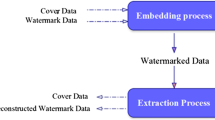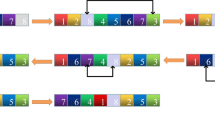Abstract
Reversible image watermarking algorithm is an important branch of information hiding, which can protect the integrity of data. Therefore, it is of great practical significance and practical value to study the reversible image water marking algorithm. A multimedia image watermarking algorithm based on two-dimensional non-causal prediction and edge based sorted pixel value difference (ESPVD) is proposed in this paper, which is used to protect the security of multimedia information. Firstly, the optimum prediction coefficients in the horizontal and vertical directions of image are calculated. Then, two-dimensional non-causal prediction of image is carried out according to raster scanning sequence, and prediction pixels and prediction errors are calculated. Finally, the morphological edge (ME) operator is used to identify edge pixel positions, and the ESPVD technology is used to embed the watermarking information. The experimental results show that the proposed algorithm has better performance than those of other image watermarking algorithms under the same embedding ability.









Similar content being viewed by others
References
Cao F, An B, Yao H et al (2019) Local complexity based adaptive embedding mechanism for reversible data hiding in digital images[J]. Multimed Tools Appl 78(7):7911–7926
Dragoi IC, Coltuc D (2015) On local prediction based reversible watermarking[J]. IEEE Trans Image Process 24(4):1244–1246
Dragoi IC, Coltuc D (2016) Adaptive pairing reversible watermarking [J]. IEEE Trans Image Process 25(5):2420–2422
Elshazly AR, Nasr ME, Fouad MM et al (2017) High payload multi-channel dual audio watermarking algorithm based on discrete wavelet transform and singular value decomposition[J]. Int J Speech Technol 20:1): 1–1): 8
Gul E, Ozturk S (2019) A novel hash function based fragile watermarking method for image integrity[J]. Multimed Tools Appl 78(13):17701–17718
Haribabu M, Bindu CH, Swamy KV (2016) A Secure & Invisible Image Watermarking Scheme Based on wavelet transform in HSI color space [J]. Procedia Comput Sci 93:462–468
Hsu LY, Hu HT (2015) Blind image watermarking via exploitation of inter-block prediction and visibility threshold in DCT domain[J]. J Vis Commun Image Represent 32(C):130–143
Jiang L, Wang J, Jiang H et al (2018) Prediction model of port throughput based on game theory and multimedia Bayesian regression[J]. Multimed Tools Appl 78(4):4397–4416
Kumar A, Cheruku DR, Chanamallu SR et al (2016) Digital watermarking approach based on edge based sorted pixel value difference (ESPVD) [J]. Indian J Sci Technol 9(S1):100706
Li X, Zhang W, Gui X et al (2017) Efficient reversible data hiding based on multiple histograms modification[J]. IEEE T Inf Foren Sec 10(9):2016–2027
Pakdaman Z, Saryazdi S, Nezamabadi-Pour H (2016) A prediction based reversible image watermarking in Hadamard domain[J]. Multimed Tools Appl 76(6):1–29
Qin C, Ji P, Wang J et al (2017) Fragile image watermarking scheme based on VQ index sharing and self-embedding[J]. Multimed Tools Appl 76(2):2267–2287
Rahmani P, Dastghaibyfard G (2018) Two reversible data hiding schemes for VQ-compressed images based on index coding[J]. IET Image Process 12(7):1195–1203
Roy A, Laskar RH (2019) Fuzzy SVM based fuzzy adaptive filter for denoising impulse noise from color images[J]. Multimed Tools Appl 78(2):1785–1804
Sakthivel SM, Sankar AR (2018) An ASIC based invisible watermarking of grayscale images using pixel value search algorithm (PVSA)[J]. Multimed Tools Appl 78:4): 1–4):27
Shu-Zhi LI, Qin HU, Deng XH (2017) Reversible image watermarking based on gray level co-occurrence matrix texture feature selection clock[J]. J Optoe Laser 28(4):411–418
Ustubioglu A, Ulutas G, Ustubioglu B (2019) IWT-MDE based reversible thermal image watermarking enhanced with secret sharing mechanism[J]. Multimed Tools Appl 78:8): 1–8):31
Wu HT, Huang J (2012) Reversible image watermarking on prediction errors by efficient histogram modification[J]. Signal Process 92(12):3000–3009
Xiang Y, Xiang W, Pei Q (2018) Reversible watermarking based on multi-dimensional prediction-error expansion[J]. Multimed Tools Appl 77(14):18085–18104
Zhang XP, Long J (2016) Lossless and reversible data hiding in encrypted images with public-key cryptography[J]. IEEE T Circ Syst Vid 26(9):1622–1631
Acknowledgements
This work is supported by the Natural Science Foundation of China (No. U1504613) and the Soft Science Research Project of Henan Intellectual Property Bureau (No. 20170106036).
Author information
Authors and Affiliations
Corresponding author
Additional information
Publisher’s note
Springer Nature remains neutral with regard to jurisdictional claims in published maps and institutional affiliations.
Rights and permissions
About this article
Cite this article
Tan, Y., Qin, J. A reversible water marking algorithm for multimedia images using two-dimensional non-causal prediction and ESPVD. Multimed Tools Appl 79, 1625–1640 (2020). https://doi.org/10.1007/s11042-019-08219-3
Received:
Revised:
Accepted:
Published:
Issue Date:
DOI: https://doi.org/10.1007/s11042-019-08219-3




